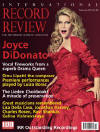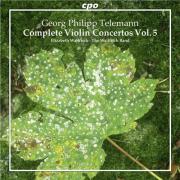Texte paru dans: / Appeared in:
*

International Record Review - (02/2013)
Pour
s'abonner / Subscription information
CPO
CPO777550

Code-barres / Barcode : 0761203755028
Consultez toutes les évaluations recensées pour ce cd
~~~~ Reach all the evaluations located for this CD
Writing about the second volume of Elizabeth Wallfisch’s survey of Telemann’s violin concertos for IRR in May 2007 I hazarded a guess that the series would run to three CDs. How wrong I have been, for here we are on Volume 5. What I had not taken into account were the works for more than one violin and the overture-suites with solo violin parts. Wallfisch appears to be leaving no stone unturned since already we have had five overture-suites and, with the appearance of this new disc, two further concertos for two and four violins.
The seven concertos assembled here belong to an early period in Telemann’s life and date mainly if not entirely from the years 1707-12 when he was Konzertmeister at the little court of Eisenach. As so often with this composer the works eschew the fast-slow-fast movement scheme of contemporary Venetian concertos in favour of a four-movement pattern in which the opening one is slow or, at least, slowish. The importance to which Telemann attached these introductory pieces is evident in each and every one of them and nowhere more so, perhaps, than in the opening Adagio of the G major Concerto. This harmonically warm and mildly elegiac music, with its freely rhapsodic violin writing, is wholly and unmistakably characteristic of Telemann’s affective vocabulary and is redolent with expressive allure .
The Concerto in B flat was clearly known to Handel since, as some readers will quickly realize, its material served as the basis for his Sonata a cinque, HWV288 (c. 1707) in the same key. Later on, as Jan Payne has ascertained, Handel returned to Telemann’s B flat Concerto , this time drawing upon its finale for his opera Ottone (1723). Payne has performed valuable editorial work on Telemann’s suites and concertos and furthermore has rendered playable the concluding movement of the Concerto in A major for four violins and strings which has survived only in fragmentary form.
As I have remarked of earlier volumes in the series, Wallfisch and her colleagues, variously belonging to The Wallfisch Band and L’Orfeo Barockorchester, are stylish and affectionate interpreters of an infrequently encountered repertoire, bringing to it a pleasing elegance and expressive ardour. While Italian features of concerto writing are seldom absent and, in some instances such as the second movement of the F major Concerto, much to the fore, Telemann ploughs his own furrow and delights our senses in so doing. Among the many qualities confronting the listener are a rich seam of invention and a feeling for detail. Wallfisch responds to the intimate, gently spoken character of these concertos with modest gestures which allow the music to speak without fussy embellishment or artificial hindrance. The beautifully poised and limpid recitative - like Grave with which the F sharp minor Concerto begins provides just one among many instances of Wallfisch’s pleasingly self-effacing rapport with Telemann. In summary, there is much to enjoy in this, dare I hazard, penultimate disc in a rewarding series. Recorded sound is excellent and Wolfgang Hirschmann’s accompanying essay informative and readable.
Cliquez l'un ou l'autre
bouton pour découvrir bien d'autres critiques de CD
Click either button for many other reviews


